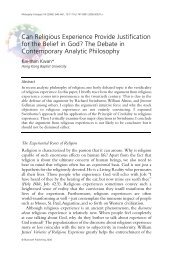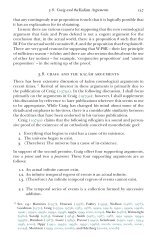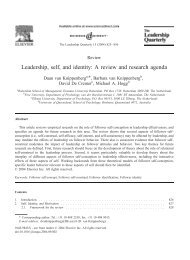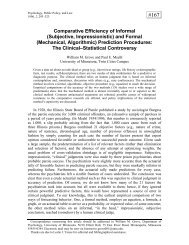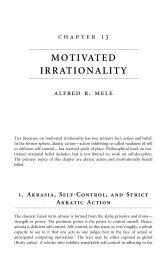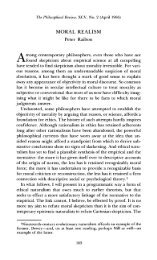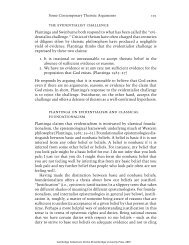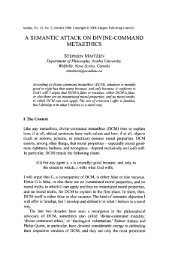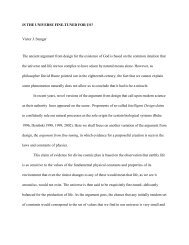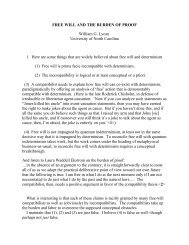Atheism and Theism JJ Haldane - Common Sense Atheism
Atheism and Theism JJ Haldane - Common Sense Atheism
Atheism and Theism JJ Haldane - Common Sense Atheism
You also want an ePaper? Increase the reach of your titles
YUMPU automatically turns print PDFs into web optimized ePapers that Google loves.
22 J.J.C. Smart<br />
argument from ostensible fine tuning is the currently fashionable form of<br />
the traditional ‘teleological argument’ for the existence of God. Sometimes<br />
this is called ‘the argument from design’ but this, like a too literal construal of<br />
‘fine tuning’, would be question begging. Years ago Norman Kemp Smith<br />
suggested that the argument should be called ‘the argument to design’. 36<br />
Equally we could call it ‘the argument from apparent design’, or for brevity<br />
‘the design argument’.<br />
Unlike some other traditional arguments for the existence of God the<br />
design argument was never meant to be apodeictic. In contrast the ontological<br />
argument was meant to be quite a priori <strong>and</strong> the cosmological argument<br />
almost so, requiring only the assertion that something contingently exists.<br />
The design argument is best thought of as an argument to the best explanation,<br />
such as we use in science <strong>and</strong> everyday life. The best explanation for the<br />
appearance of design in the world is said to be a designer.<br />
David Hume in his great posthumously published book, Dialogues<br />
Concerning Natural Religion, 37 obviously thought that there were alternative<br />
explanations which are as plausible as that of design. However, he retained<br />
a sceptical position, rather than a dogmatically atheist one. Philo, who was<br />
probably Hume’s representative mouthpiece in the Dialogues, said that the<br />
universe might as well be compared to an organism as to an artefact, <strong>and</strong><br />
organisms, prima facie, are not designed. They ‘just grow’. (Antony Flew has<br />
commended the childlike acumen <strong>and</strong> common sense of Topsy in Harriet<br />
Beecher Stowe’s Uncle Tom’s Cabin. 38 ) Of course we know from the modern<br />
synthesis of the theory of evolution by natural selection together with<br />
neo-Mendelian genetics that organisms do not need to have been designed.<br />
If we appreciate the huge time-scale of evolutionary processes <strong>and</strong> the opportunistic<br />
way in which they work, our minds need not be intellectually<br />
overwhelmed, even though perhaps imaginatively at a loss. However, I am<br />
here considering the argument from design in a post-Darwinian context,<br />
the new teleology not the old, in relation to the great appearance of design in<br />
the laws of physics.<br />
As was just remarked, Hume held that the analogy between the universe<br />
<strong>and</strong> an organism was as good as that between the universe <strong>and</strong> an artefact.<br />
There are possibly many other analogies, equally good or bad. Indeed Hume’s<br />
Dialogues concludes with Philo’s concession to his main interlocutor Cleanthes<br />
that there is some analogy between the cause of the universe <strong>and</strong> a human<br />
mind. This is perhaps in one way a very small concession since with enough<br />
ingenuity one can find some analogy between almost any two things. However,<br />
in another way it is a big concession, namely that the universe does have<br />
a cause external to itself.<br />
One trouble with the design argument is that there would have to be<br />
a ‘cosmic blueprint’ 39 in the mind of God. This conflicts with the supposition



